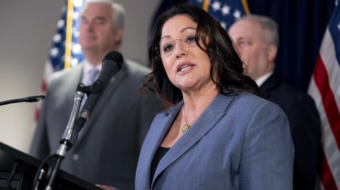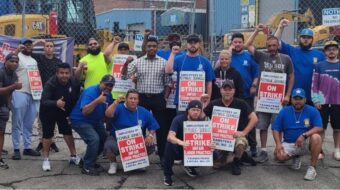CHARLESTON, W.Va. – Although they get the headlines and the TV crews, coal mine explosions and cave-ins have not been the leading cause of death of coal miners for 50 years. Black lung, a disease that destroys the lungs as a result of breathing coal dust, killed 55,000 miners between 1968 and 1990 and still takes the lives of 1,000 miners per year.
The Bush administration is proposing a federal takeover of dust testing and to dramatically loosen the standards for conducting the tests. Currently the coal mine operators do the testing. The 1969 Black Lung Bill, or Coal Mine Health and Safety Act, requires 34 coal dust tests per year per mine. The Bush Administration would take over the sampling and reduce the number of tests to three or six per year at some mines.
Carrying signs saying, “Dust Kills” and “Less Sampling Equals more Health Problems,” over 500 miners protested on the Capitol steps in Charleston as the Mine Safety and Health Administration (MSHA) held a hearing on the changes on May 8.
The new regulations “show the complete disregard that David Lauriski and the Bush administration have for miners and working people in general,” United Mine Workers of America (UMWA) District 17 (Charleston area) President Joe Carter told the rally.
Bush appointed Lauriski assistant labor secretary for mine health and safety in 2002. Lauriski was a coal company executive for 30 years.
“Monstrous, complicated and wrong-headed” was Joseph Main’s reaction to the proposed changes. Main is the director of the UMWA’s safety and health department.
“We’re talking about reversing back to (dust conditions) prior to the 1969 Act,” said Main. “Miners would breathe more dust under this rule.”
There is a solution, said union President Cecil Roberts. “The debate over reforming the respirable dust program must be resolved in favor of miners’ health – not operator interests,” he said. The union, some operators, and doctors support the use of a new continuous dust sampling device developed by the National Institute of Occupational Health and Safety.
Marvin Nichols, director of the MSHA’s standards office, backs the use of air purifying respirators completely enclosing a miner’s head, like a helmet.
President Roberts questioned the proposal, saying that the helmet is heavy, cumbersome and uncomfortable. The 1969 Black Lung Act specifically says that “respirators shall not be substituted for environmental control measures in the active workings of coal mines.”
The National Mining Association, a consortium of coal and energy companies, has not taken an official position on the changes. Association spokesman Bruce Watzman said that the industry supports federal take over of dust sampling, but is still working to understand other proposed changes in the regulations.
A 1998 Louisville Courier-Journal series exposed widespread fraud, scams and scandals in coal dust testing conducted by the mine owners. After interviewing 255 working and retired miners and studying seven million government documents, the newspaper concluded that the tests were tainted and that enforcement of standards was lax. Inspections were botched, with 11 inspectors convicted of taking bribes. Dust inspections were more accurate in union mines than non-union mines.
The newspaper found that strip miners also contracted Black Lung because of the amount of dust swirling in those above-ground facilities.
In an interview, the safety director of Shamrock Mining, one of the largest companies in the country, said, “The health of the men never entered into it. Controlling the dust just wasn’t part of the calculation. Production is number one.”
The hearing in Charleston is one of a series that began in Washington County, Pa. MSHA will be holding field hearings in Evansville, Ind., Lexington, Ky., Birmingham, Ala., and Grand Junction, Colo. The UMWA will participate in each one and is organizing demonstrations to save miners’ health.









